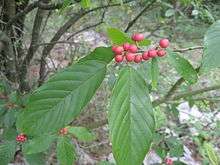Rhamnus caroliniana
| Rhamnus caroliniana | |
|---|---|
 | |
| Scientific classification | |
| Kingdom: | Plantae |
| (unranked): | Angiosperms |
| (unranked): | Eudicots |
| (unranked): | Rosids |
| Order: | Rosales |
| Family: | Rhamnaceae |
| Genus: | Rhamnus |
| Species: | R. caroliniana |
| Binomial name | |
| Rhamnus caroliniana Walter 1788 not Blanco 1837 | |
 | |
| Generalized natural range of Rhamnus caroliniana | |
| Synonyms[1] | |
| |
Rhamnus caroliniana, the Carolina buckthorn, is an upright shrub or small tree native to the southeastern, south-central, and mid-western parts of the United States, from Texas east to Florida and north as far as Maryland, Ohio, Missouri, and Oklahoma.[2] There is also an isolated population in the State of Nuevo León in northeastern Mexico.[3]
Description
Rhamnus caroliniana is usually around 12 to 15 feet (3.6-4.5 meters) high, but capable of reaching 40 feet (12 meters) 25/3in a shaded location.[4] The most striking characteristic of this plant are its shiny, dark green leaves. The flowers are very small and inconspicuous, pale yellow-green, bell-shaped, appearing in leaf axils in late spring after the leaves. The fruit is a small (1/3 inch or 8.3 mm) round drupe; at first red, but later turning black with juicy flesh. It ripens in late summer.[5]
Despite its common name, the Carolina buckthorn is completely thornless.
References
- ↑ Tropicos, Rhamnus caroliniana Walter
- ↑ Biota of North America Program 2014 county distribution map
- ↑ "Rhamnus caroliniana Range Map" (PDF). United States Geological Survey. Retrieved 2009-07-07.
- ↑ "Rhamnus caroliniana Carolina Buckthorn" (PDF). University of Florida. Retrieved 2009-07-07.
- ↑ Fragula caroliniana Fact Sheet (Virginia Tech)
External links
| Wikimedia Commons has media related to Rhamnus caroliniana. |